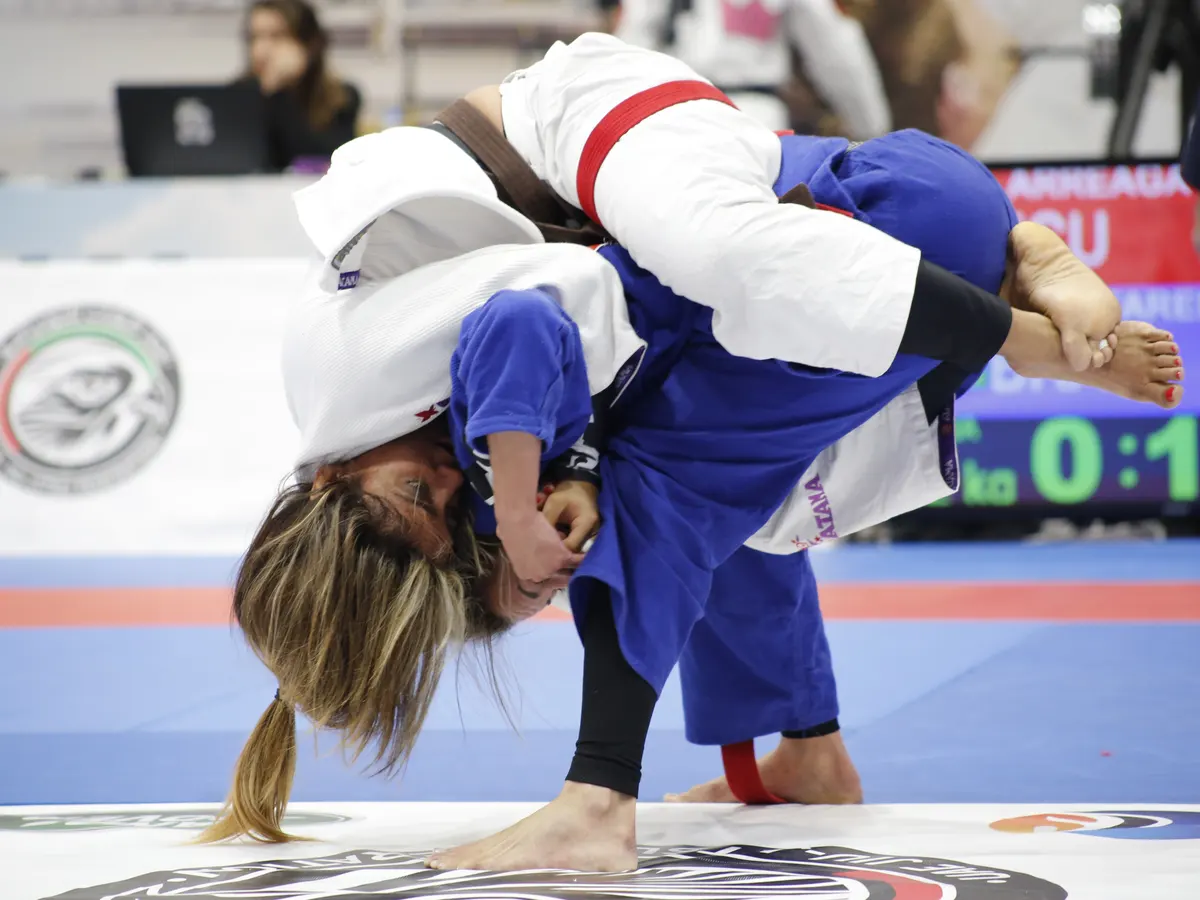
Brazilian Jiu-Jitsu (BJJ) is a martial art and combat sport that originated in Brazil. It has gained immense popularity worldwide due to its effectiveness in self-defense and competitive fighting. Developed from traditional Japanese Jiu-Jitsu, BJJ focuses on ground fighting techniques and submissions, making it a fundamental part of mixed martial arts (MMA).
In this article, we will delve into 20 fascinating facts about Brazilian Jiu-Jitsu that will give you a deeper understanding of its rich history, philosophy, and techniques. Whether you are a beginner looking to learn more about BJJ or a seasoned practitioner seeking to expand your knowledge, these facts will surely spark your interest and appreciation for this dynamic martial art.
Key Takeaways:
- Brazilian Jiu-Jitsu originated in Brazil and focuses on ground fighting and submission holds, gaining popularity after Royce Gracie’s success in the early UFC.
- BJJ offers physical and mental benefits, with a global following and opportunities for people of all ages to learn and compete.
Origin
Brazilian Jiu-Jitsu (BJJ) originated in Brazil and was developed from Kodokan Judo by the Gracie family in the early 20th century.
Self-Defense Art
BJJ is predominantly a martial art and combat sport that focuses on ground fighting and submission holds.
Gi and No-Gi
There are two main styles of BJJ: gi, which involves wearing a traditional kimono, and no-gi, which is practiced without the gi.
Principle of Leverage
BJJ techniques are based on the principle of using leverage and technique rather than brute strength to overcome opponents.
Ground Fighting Dominance
BJJ places a strong emphasis on the ground game, including control positions, sweeps, and submissions.
UFC Influence
BJJ gained popularity globally after Royce Gracie showcased its effectiveness in the early days of the UFC, defeating larger opponents.
Belt Ranking System
BJJ uses a belt ranking system, which progresses from white belt (beginner) to black belt (expert), with several intermediary ranks in between.
Respect for the Gracie Family
The Gracie family is highly respected in the BJJ community for their contributions to the sport and their role in spreading its popularity.
Physical and Mental Benefits
Practicing BJJ offers a range of benefits, including improved physical fitness, increased mental focus, and enhanced self-discipline.
Global Participation
BJJ has gained a worldwide following, with practitioners and competitions in countries across the globe.
The Guard Position
The guard position is a key aspect of BJJ, allowing the practitioner to defend and attack from their back.
Submission Holds
BJJ is renowned for its vast array of submission holds, including joint locks and chokes.
Competitions and Tournaments
There are numerous BJJ competitions and tournaments held worldwide, ranging from local events to prestigious international championships.
Training Academies
BJJ training academies, known as dojos or gyms, provide a supportive environment for practitioners to learn and progress.
Women in BJJ
BJJ is increasingly popular among women, and there are numerous talented female practitioners and champions in the sport.
BJJ in Mixed Martial Arts
Many successful mixed martial artists have a background in BJJ, utilizing its techniques to gain an advantage in the cage.
International BJJ Federation
The International Brazilian Jiu-Jitsu Federation (IBJJF) is the main governing body for BJJ competitions and rankings.
BJJ for All Ages
BJJ is suitable for people of all ages, from children to seniors, with specialized training programs available for different age groups.
BJJ Philosophy
In addition to physical techniques, BJJ also emphasizes self-improvement, respect, and discipline, promoting a well-rounded approach to life.
Never Stop Learning
One of the key principles of BJJ is the idea of constantly learning and evolving, with practitioners always seeking to improve their skills.
Conclusion
In conclusion, Brazilian Jiu-Jitsu is a fascinating and dynamic martial art that offers a multitude of benefits. Whether you are a seasoned athlete or a beginner looking to try something new, Brazilian Jiu-Jitsu provides a challenging yet rewarding experience that enhances both physical and mental well-being. The art’s emphasis on leverage, technique, and strategy makes it suitable for practitioners of all ages and body types.By practicing Brazilian Jiu-Jitsu, you can improve your strength, flexibility, and overall fitness level. Additionally, the art promotes discipline, patience, and resilience, which carry over into other aspects of life. It offers a unique combination of physical activity, self-defense skills, and camaraderie within a supportive community.So, why not give Brazilian Jiu-Jitsu a try? Whether you aspire to compete, want to learn self-defense techniques, or simply want to stay active and have fun, Brazilian Jiu-Jitsu has something to offer everyone.
FAQs
1. How long does it take to become proficient in Brazilian Jiu-Jitsu?
Proficiency in Brazilian Jiu-Jitsu varies depending on individual dedication, natural aptitude, and training frequency. It typically takes several years of consistent training to reach a high level of proficiency.
2. Is Brazilian Jiu-Jitsu suitable for everyone?
Yes, Brazilian Jiu-Jitsu is suitable for people of all ages, genders, and fitness levels. It can be adapted to accommodate individual abilities and limitations.
3. Do I need to have previous martial arts experience to start Brazilian Jiu-Jitsu?
No, previous martial arts experience is not required. Brazilian Jiu-Jitsu is beginner-friendly, and many academies offer classes specifically designed for beginners.
4. Is Brazilian Jiu-Jitsu an effective form of self-defense?
Yes, Brazilian Jiu-Jitsu is highly effective for self-defense. It focuses on using leverage and technique to overcome larger and stronger opponents.
5. Are there tournaments and competitions in Brazilian Jiu-Jitsu?
Yes, Brazilian Jiu-Jitsu has a vibrant tournament scene with various competitions held globally. Participating in tournaments can be a great way to test your skills and measure your progress.
6. Can Brazilian Jiu-Jitsu help with weight loss and fitness goals?
Absolutely! Brazilian Jiu-Jitsu is a rigorous physical activity that can help you burn calories, improve cardiovascular health, and build strength and endurance.
7. What should I wear to Brazilian Jiu-Jitsu classes?
You can wear a traditional Brazilian Jiu-Jitsu gi (uniform) or a rash guard and shorts. Make sure to check with your local academy for their specific dress code requirements.
8. Are there belts or ranks in Brazilian Jiu-Jitsu?
Yes, Brazilian Jiu-Jitsu utilizes a belt ranking system to denote a practitioner’s level of proficiency. The belt colors progress from white to black, with additional degrees indicated by stripes on the belt.
Hungry for more Brazilian Jiu-Jitsu knowledge? Satisfy your curiosity with our other captivating articles. Unearth additional BJJ facts that will leave you amazed and inspired. Explore the extraordinary world of this martial art, from its techniques to its culture. Plus, delve into the life of Rorion Gracie, a key figure in BJJ's history, and learn intriguing details about his journey. Keep reading to expand your understanding of Brazilian Jiu-Jitsu and its incredible impact on the martial arts community.
Was this page helpful?
Our commitment to delivering trustworthy and engaging content is at the heart of what we do. Each fact on our site is contributed by real users like you, bringing a wealth of diverse insights and information. To ensure the highest standards of accuracy and reliability, our dedicated editors meticulously review each submission. This process guarantees that the facts we share are not only fascinating but also credible. Trust in our commitment to quality and authenticity as you explore and learn with us.


